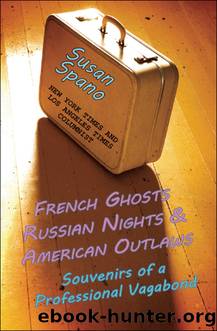French Ghosts, Russian Nights, and American Outlaws by Susan Spano

Author:Susan Spano [Spano, Susan]
Language: eng
Format: epub
ISBN: 9781938901263
Publisher: Roaring Forties Press
14
RENÃ MAGRITTEâS BRUSSELS
The artist René Magritte spent almost all his life in Brussels. While other surrealists dressed bizarrely, swapped lovers, and made flamboyantly deviant art, he remained an inconspicuous fellow, tending toward portliness, who painted flaming tubas and dismembered body parts every morning in his dining room with the regularity of a bank clerk. His great escape was to put on a bowler hat and walk his dogâa Pomeranian named Loulouâin buttoned-up, bourgeois Brussels.
A story is told about the artist stopping at the corner store to buy some cheese. The grocer started to cut a slice, but Magritte insisted on a piece from another round. When she protested that both were the same, he said, âNo, Madame, the one in the window has been looked at all day long by people passing by.â
Knowing Belgians, I imagine that madame simply nodded her grizzled head and complied. But visitors to the sane, grey Belgian capital are bound to feel perplexed about how Magritte fit in so comfortably there, indeed, chose it over Paris, where he spent three years from 1927 to 1930 hobnobbing with the wilder French surrealists.
Up until a few years ago, Magritteâs steps were hard to trace in Brussels, which made little of him, though by the time of his death in 1967, New Yorkâs Museum of Modern Art had mounted a major Magritte retrospective, avant-garde artists such as Andy Warhol and Jasper Johns collected his work, and the Beatles had taken his signature green apple as a logo. Indeed, on my first visit to Brussels in 1994, I had to seek out the room dedicated to him in the Musées Royaux des Beaux Arts.
In 2009, however, the Brussels Beaux Arts literally took Magritte out from under wraps by opening a stand-alone museum dedicated to him in the 18th-century Hotel Altenloh on the Place Royale. For months before the museum opened its doors, the facade was covered by a massive tarp that depicted curtains parting to reveal Magritteâs iconic The Empire of Lights. By the end of its first year, half a million people had toured the museum, a major new city site that makes it possible to now speak of visiting Magritteâs Brussels in the same way people go to Aix-en-Provence for Cézanne and Amsterdam for Van Gogh.
The waiting lines had shortened by the time I visited the Magritte museum recently. Inside its renovated neoclassical façade, I found everything state-of-the-art and 100 percent green (thanks to financial and technical support from the French energy conglomerate GDF Suez), laid out on six levels, with bemusing touches such as bathroom mirrors shaped like Magritteâs man in a bowler hat. The galleries follow the artistâs development chronologically, beginning with his birth in 1898 and middle-class childhood in the town of Chatelet, about 25 miles south of Brussels.
Anecdotes abound about his youthful peculiaritiesâplaying in cemeteries, celebrating Mass dressed as a priest, hanging yowling cats by their legs on doorbell pull cordsâsome apparently concocted by Magritte himself. What is known about his childhood is
Download
This site does not store any files on its server. We only index and link to content provided by other sites. Please contact the content providers to delete copyright contents if any and email us, we'll remove relevant links or contents immediately.
How to Read Water: Clues and Patterns from Puddles to the Sea (Natural Navigation) by Tristan Gooley(3410)
Full Circle by Michael Palin(3394)
Into Thin Air by Jon Krakauer(3316)
How to Read Nature by Tristan Gooley(3253)
In Patagonia by Bruce Chatwin(2878)
The Lost Art of Reading Nature's Signs by Tristan Gooley(2626)
A Thousand Splendid Suns by Khaled Hosseini(2620)
Don't Sleep, There Are Snakes by Daniel L. Everett(2578)
Venice by Jan Morris(2527)
City of Djinns: a year in Delhi by William Dalrymple(2516)
The Songlines by Bruce Chatwin(2499)
The Queen of Nothing by Holly Black(2499)
L'Appart by David Lebovitz(2488)
The Big Twitch by Sean Dooley(2394)
Tokyo Geek's Guide: Manga, Anime, Gaming, Cosplay, Toys, Idols & More - The Ultimate Guide to Japan's Otaku Culture by Simone Gianni(2319)
Come, Tell Me How You Live by Mallowan Agatha Christie(2214)
Iranian Rappers And Persian Porn by Maslin Jamie(2159)
INTO THE WILD by Jon Krakauer(2158)
A TIME OF GIFTS by Patrick Leigh Fermor(2156)
